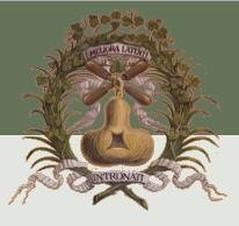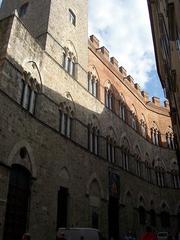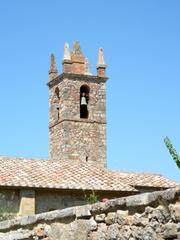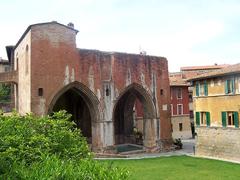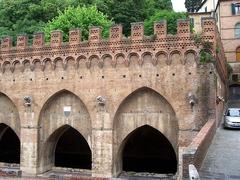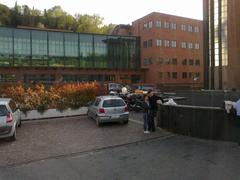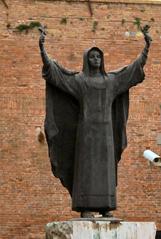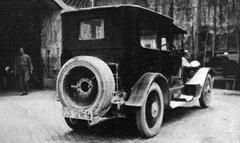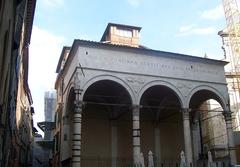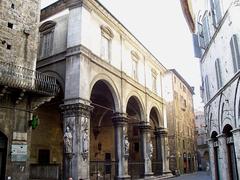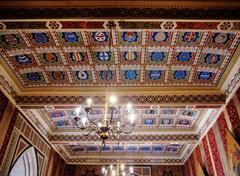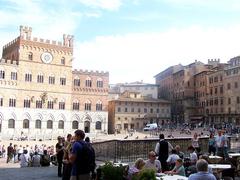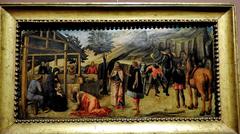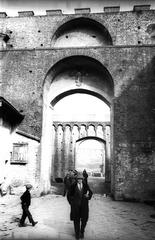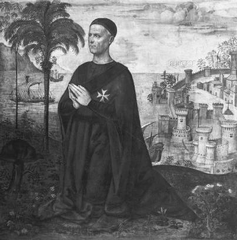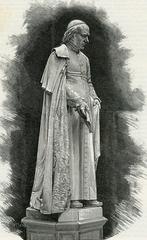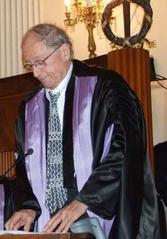Abbadia Nuova Siena: Visiting Hours, Tickets, and Historical Sites Guide
Date: 14/06/2025
Introduction
Abbadia Nuova, situated just outside Siena in the heart of Tuscany, is a captivating blend of religious, artistic, and community heritage. This landmark, known for its medieval foundations and enduring ties to Siena’s artisan guilds, offers modern visitors a unique window into the region’s spiritual traditions, craftsmanship, and vibrant cultural life. The abbey’s historical significance is enhanced by its architectural evolution, connections to the Via Francigena pilgrimage route, and ongoing role as a hub for festivals and cultural exchange. Whether you are drawn by medieval art, sacred rituals, or Tuscan tradition, this guide will provide detailed information on Abbadia Nuova’s history, cultural context, visitor logistics, and tips for a memorable visit (OKSiena).
Table of Contents
- Discover Abbadia Nuova: A Unique Siena Historical Site
- Origins and Foundation
- Medieval Significance and the Guild System
- Architectural Features and Artistic Heritage
- The Role of Abbadia Nuova in Sienese Society
- Modern Revitalization and Cultural Exchange
- Practical Visitor Information: Hours, Tickets, and Accessibility
- Preservation and Visitor Experience
- Frequently Asked Questions (FAQ)
- Abbadia San Salvatore: History and Architecture
- Visitor Information for Abbadia San Salvatore
- Architectural and Cultural Significance
- Mining Heritage and Museums
- Planning Your Visit: Directions, Accommodation, and Seasonal Highlights
- Traditions, Festivals, and Local Life
- Visuals and Media
- Further Reading and References
- Summary and Visitor Recommendations
Discover Abbadia Nuova: A Unique Siena Historical Site
Nestled within Siena’s historic landscape, Abbadia Nuova stands out for its deep-rooted connections to religious devotion and the artisan tradition. The abbey, historically the center of the “Arte dei Vasai” (Guild of Potters), has been a focal point for spiritual life, artistic creation, and community celebration. Today, it remains an accessible and enriching destination for those seeking to understand Siena’s layered past and living culture.
Origins and Foundation
Abbadia Nuova’s origins date to the medieval era, when Siena flourished as a center for trade, craft, and religious pilgrimage. The site’s dedication to Saints James and Philip reflects its foundational role as the spiritual headquarters of the potters’ guild, whose members contributed both to daily life and the city’s artistic legacy (OKSiena). The abbey’s early development paralleled Siena’s rise as a regional power.
Medieval Significance and the Guild System
Siena’s guilds were pillars of the city’s medieval society, shaping its economic, social, and spiritual fabric. The “Arte dei Vasai” not only produced essential ceramics but also played a vital role in the decoration of Siena’s civic and religious spaces. Abbadia Nuova acted as the guild’s spiritual and communal heart, hosting ceremonies and festivals still celebrated today, such as the annual “Festa dell’Abbadia Nuova” (OKSiena).
Architectural Features and Artistic Heritage
Abbadia Nuova is a testament to Siena’s architectural evolution, blending Romanesque solidity with Renaissance grace. Visitors will find original stonework, an understated façade, and decorative elements—particularly ceramics—that echo the community’s artisanal roots. The abbey’s ongoing partnership with Centuripe, Sicily, renowned for its Hellenistic ceramics, illustrates a living tradition of craft and cultural exchange (OKSiena).
The Role of Abbadia Nuova in Sienese Society
Beyond its religious function, Abbadia Nuova has always been a center for community life, especially in the Nicchio district. Events such as the “Festa dell’Abbadia Nuova” unite locals and visitors through processions, exhibitions, and artisan demonstrations, all organized by the historic Nobile Contrada del Nicchio. These celebrations honor both the guild’s legacy and contemporary cultural vitality (OKSiena).
Modern Revitalization and Cultural Exchange
In recent years, Abbadia Nuova has experienced a renaissance as a platform for cultural innovation. The 2025 festival, for instance, spotlighted a collaboration with Sicilian master potters, featuring exhibitions, live demonstrations, and scholarly exchanges. Such partnerships bridge regional traditions and reinforce the abbey’s reputation as a dynamic center for craft and culture (OKSiena).
Practical Visitor Information: Hours, Tickets, and Accessibility
- Visiting Hours: Generally open during religious services and special events; extended hours during the annual festival (May). For current times, consult the Nobile Contrada del Nicchio or Siena tourism sites.
- Tickets: Entry is typically free for regular visits; special exhibitions or guided tours may have a modest fee.
- Accessibility: The site offers some accessible features, though certain historic areas may pose challenges. Contact in advance for details.
- Guided Tours: Available during festivals or by appointment, offering insights into the abbey’s history, art, and traditions.
- Nearby Attractions: Within walking distance of Siena’s Piazza del Campo and the Cathedral of Santa Maria Assunta.
Preservation and Visitor Experience
Abbadia Nuova is actively preserved by the Contrada del Nicchio, ensuring that its blend of medieval tradition and modern creativity remains accessible to all. The annual festival, in particular, provides a vibrant immersion into local culture and craftsmanship.
Frequently Asked Questions (FAQ)
Q: What are the visiting hours?
A: Open during services, festivals, and by appointment; extended hours during the May festival.
Q: Is there an entry fee?
A: Generally free; some events or tours may require a ticket.
Q: Are guided tours available?
A: Yes, especially during festivals or with prior arrangement.
Q: Is the site accessible for those with mobility issues?
A: Some areas are accessible, but historic features may limit full access. Contact ahead for assistance.
Q: What other sites are nearby?
A: Piazza del Campo, Siena Cathedral, and other iconic landmarks.
Abbadia San Salvatore: History and Architectural Evolution
Foundation and Early Development
Founded in 743 by Lombard king Rachis, the Abbey of San Salvatore (often referenced as Abbadia Nuova in local tradition) is one of Tuscany’s most significant monastic complexes. Initially Benedictine, it later became Cistercian, with architecture reflecting Romanesque, Gothic, and later influences (TuscanyPeople; Visit Tuscany).
Architectural Highlights
- Romanesque Features: Thick walls, semicircular arches, and a crypt supported by repurposed Roman/Etruscan columns.
- Gothic/Cistercian Elements: Pointed arches, elongated proportions, and a focus on light and simplicity.
- Interior Artistry: Frescoes, sculpted capitals, and liturgical furnishings from the 13th–14th centuries.
- Cloister and Monastic Complex: Arcaded walkways and preserved monastic buildings.
Visitor Information for Abbadia San Salvatore
- Opening Hours: Typically Tuesday–Sunday, 9:00 AM–6:00 PM; closed Mondays and major holidays (Abbazia San Salvatore official site).
- Tickets: ~€5 for adults; discounts for seniors/students; guided tours available.
- Accessibility: Some areas (e.g., crypt) may be challenging for those with mobility limitations.
- Facilities: Restrooms and basic visitor amenities are available.
Architectural and Cultural Significance
The Abbey and Village
Abbadia San Salvatore’s church features a crypt with 32 unique columns, Baroque frescoes, and a cloister. The medieval borgo boasts narrow stone streets, the Palazzo del Podestà, and several historic churches (TuscanyPeople).
Sites Beyond the Walls
Notable churches nearby include San Leonardo and Madonna dei Remedi. Natural sites like the Rupe di Dante and Grotta dell’Arciere add to the area’s allure (Visit Tuscany).
Mining Heritage and Museums
The mercury mines of Abbadia Nuova played a crucial role in the area’s modern history. The Mining Museum (Parco Museo Minerario) offers guided tours of tunnels, exhibits on geology and mining history, and insights into the community’s transformation (Visit Tuscany).
Planning Your Visit: Directions, Accommodation, and Seasonal Highlights
- Getting There: About 1 hr 15 min by car from Siena; accessible via Via Cassia (SR2) and regional bus lines.
- Exploring: Walk the medieval center; try local hiking and cycling trails in Monte Amiata’s forests (TuscanyPeople).
- Accommodation & Dining: Range of B&Bs, hotels, and trattorias serving local specialties.
- Seasonal Highlights: Chestnut harvest (autumn), hiking (spring/summer), Fiaccole torch festival (Christmas), and snow sports (winter).
Traditions, Festivals, and Local Life
The Fiaccole (Christmas Eve Torch Lighting)
A centuries-old tradition where the town gathers to light wooden pyres, sing, and share mulled wine (Visit Tuscany).
The Giudeata (Easter Procession)
Dramatic reenactment of the Passion of Christ, featuring costumed townspeople and illuminated lanterns (TuscanyPeople).
Gastronomy
Enjoy local dishes like mushroom and chestnut soup, pici pasta, cinta senese salumi, and the exclusive Ricciolina dessert (Visit Tuscany).
Visuals and Media
- Abbey of San Salvatore: Exterior and crypt
- Frescoes by Francesco Nasini: Baroque artistry
- Mining Museum: Entry and tunnels
- Map: Location relative to Siena
Explore virtual tours and high-quality images via official tourism websites.
Summary and Visitor Recommendations
Abbadia Nuova is a living testament to Siena’s spiritual, artisanal, and communal traditions. From its medieval roots as the hub of the potters’ guild to its role today as a site of vibrant cultural exchange, the abbey offers a rich visitor experience. Its proximity to Siena’s historic center, accessible visiting hours, and engaging events make it an ideal addition to any Tuscan itinerary. Whether you are a history enthusiast, art lover, or pilgrim, Abbadia Nuova promises a deeply rewarding journey—enhanced by guided tours, local festivals, and authentic Tuscan gastronomy. For the latest updates, guided content, and insider tips, leverage resources like the Audiala app and stay connected with local tourism platforms (OKSiena; Siena Tourism; Lonely Planet).
References and Further Reading
- OKSiena – Abbadia Nuova, Contrada del Nicchio, and Centuripe Collaboration
- TuscanyPeople – Abbadia San Salvatore
- Visit Tuscany – Abbadia San Salvatore
- Lonely Planet – Abbadia a Isola
- It’s Tuscany – The History of Siena
- Siena Tourism Website
- Abbazia San Salvatore Official Site
- Mining Museum Official Site
